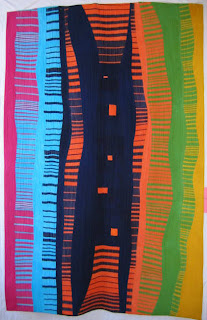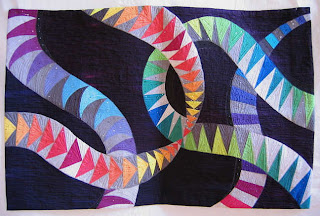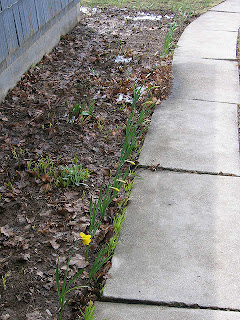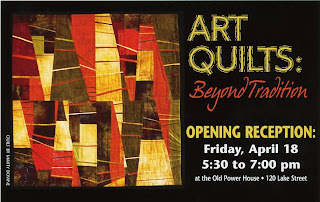









Exploring the creative journey...MY creative journey...as expressed through textiles. What nurtures it, what blocks it? Inspirations, frustrations and "doing the work." Oh yes - and the occasional rant.


















"There were solutions. Some you discovered, some you made, some you willed, some you forced."~ Richard Russo, Nobody's Fool
















 So my idea is to create a textile piece that makes the viewer uneasy, even agitated, would show the disruption change can create. I thought I could choose colors that when placed together would vibrate, clash. After a bit of research into the effects of color, I decided to start with just two: a really vibrant lime green and a strong red. I tried other colors against those two, but because I'm working small and didn't want to fuss a lot, I decided these two working against each other was enough. It's hard to capture the effect on screen - you'll just have to trust me that the eye does not rest easy on these two. I cut some strips in various widths and sewed them together. Here you see the beginning of that process.
So my idea is to create a textile piece that makes the viewer uneasy, even agitated, would show the disruption change can create. I thought I could choose colors that when placed together would vibrate, clash. After a bit of research into the effects of color, I decided to start with just two: a really vibrant lime green and a strong red. I tried other colors against those two, but because I'm working small and didn't want to fuss a lot, I decided these two working against each other was enough. It's hard to capture the effect on screen - you'll just have to trust me that the eye does not rest easy on these two. I cut some strips in various widths and sewed them together. Here you see the beginning of that process.










This has not been a good week for the studio, and today's try did not get me very far. I'm at a bit of an impasse over the last thread color to add - my several tries have not worked as anticipated. So in lieu of showing you studio progress, I'm sharing information about the upcoming Pend Orielle Arts Council invitational exhibit Art Quilts: Beyond Tradition.
I have two pieces in the exhibit which opens next Friday, April 18 with a reception from 5:30 - 7:00 p.m. and runs through June 8. If you are in the area, please check it out. The exhibit space in the Old Power House at 120 Lake Street in Sandpoint, ID encompasses two levels of an atrium-like space surrounded by office space and a restaurant. Natural light should show off the quilts to their best advantage. The one shown above, by the way, is by the organizer of the exhibit, Marty Bowne, and is being raffled to raise money for POAC.


"...created from found treasures...the resurrection of dead debris...do not interpret this pejoratively - on the contrary - for giving new form and aesthetic life to things cast away, is rather a divine act."
French critic Legrand-Chabrier, 1929, in reference to Cirque Calder by Alexander Calder

